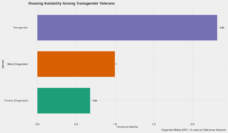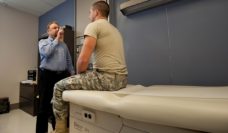Each year, an estimated 200,000 American veterans leave military service. Little is known about how these veterans fare during the transition to civilian life, which can be a period of unique and stressful challenges.
Using data from the Veterans Metrics Initiative Study, a public-private research partnership managed by the Henry M. Jackson Foundation for the Advancement of Military Medicine, our research team examined military veterans’ health and well-being during the first year after leaving service. We examined veterans’ status, functioning, and satisfaction in four domains of well-being: health, work, intimate relationships, and broader social relationships. Differences among groups of veterans were also examined to assess disparities in health and well-being. Over 7,000 veterans completed an online survey within approximately 90 days of leaving service (Time 1) and then completed the survey again about six months later (Time 2).
Overall Health and Well-Being
Health conditions were the most salient concern reported by new veterans. At the time of separation, about half of veterans reported a physical health condition and almost one-third reported a mental health condition. The most commonly-reported health conditions were chronic pain, sleep problems, anxiety, and depression. Sixty-nine percent reported good health functioning, but a slight majority (52%) were not satisfied with their health.
Despite these health concerns, veterans generally reported high work and social well-being, with many veterans indicating that they were functioning well and satisfied with their work, intimate relationships, and broader social relationships.
There was little change in veterans’ health and well-being from Time 1 (T1) to Time 2 (T2), except for an increase in the percentage of veterans who reported working (T1=57%; T2=68%) and a decrease in the percentage of veterans who reported functioning well at work (T1=93%; T2=87%).
Future directions for this research will include examining veterans’ health and well-being in the next two years after transitioning out of the military and examining the impact of veterans’ health conditions on other aspects of their post-military readjustment.
Gender
More men reported working at both time points. Men were also more likely to report having a hearing condition, high blood pressure, and high cholesterol, while females were more likely to report anxiety and depression at both time points. No other meaningful differences in well-being were found.
Rank
Differences among military ranks, specifically officers and enlisted personnel, were examined. Officers reported higher well-being in most domains at both time points. Enlisted personnel were more likely to endorse sleep problems, anxiety, depression, and post-traumatic stress disorder at both time points. Officers were more likely to endorse high cholesterol at Time 1.
War-Zone Deployment History
Veterans who were previously deployed to a war-zone were compared to veterans who were not deployed. Deployed veterans were more likely to report being in an intimate relationship at both time points. Deployed veterans were also more likely to report chronic pain, sleep problems, arthritis, a hearing condition, post-traumatic stress disorder, high blood pressure, and high cholesterol. No other meaningful differences were observed on other aspects of well-being.
Overall, military veterans reported relatively high work and social well-being during the first year after leaving military service, illustrating the resilience of the newest generation of military veterans. However, many veterans reported health concerns and were less satisfied with their health than other aspects of their lives. Given that health conditions are known to erode broader well-being, these findings highlight the importance of prevention and early intervention efforts, including bolstered health screening as veterans leave military service.
Future directions for this research will include examining veterans’ health and well-being in the next two years after transitioning out of the military and examining the impact of veterans’ health conditions on other aspects of their post-military readjustment. These analyses are currently underway by our research team. A better understanding of this transition period will help inform the work of the over 40,000 organizations that provide services intended to assist U.S. veterans with reintegration.
Photo by israel palacio on Unsplash















